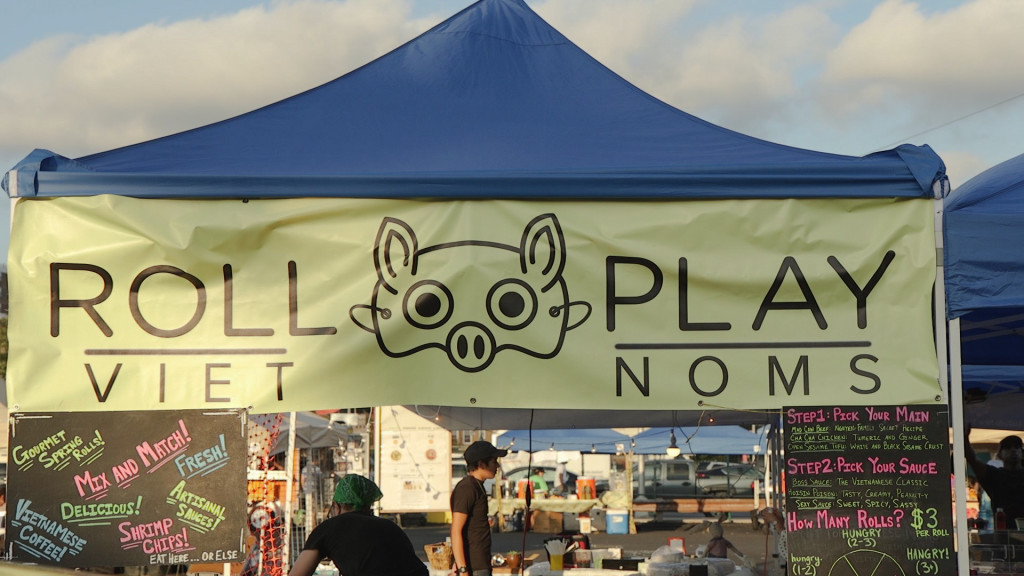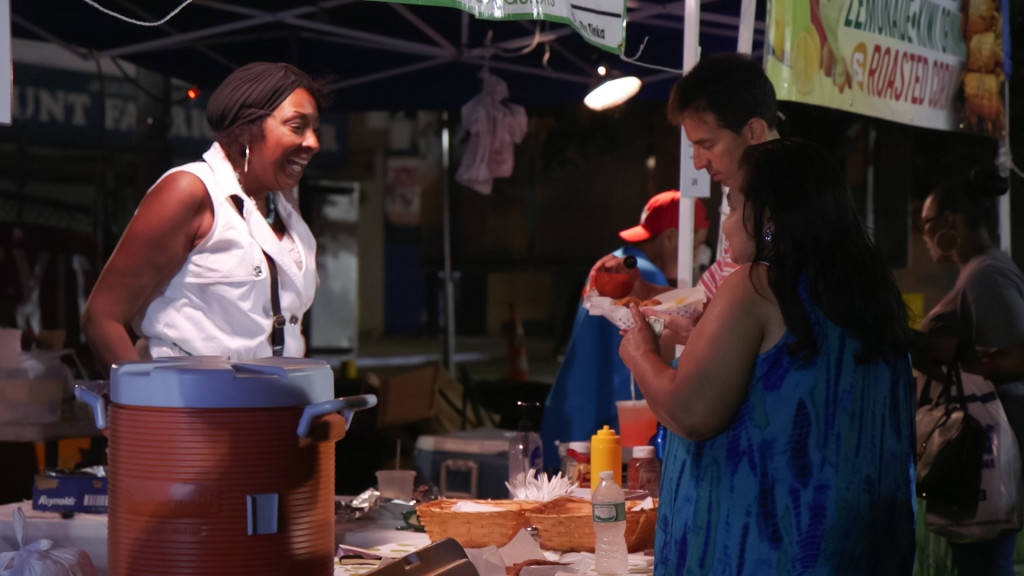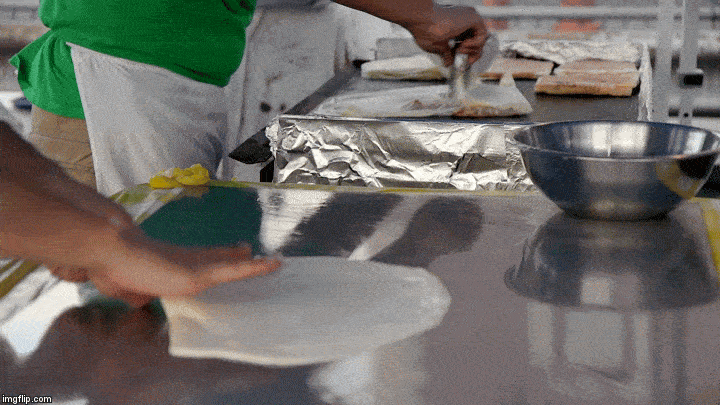Podcast: Saving Pearl River Mart, A Personal History of NYC’s Legendary Chinese Department Store
Producer Michelle Chen tells the surprising story behind her family’s famous store.
Producer Michelle Chen tells the surprising story behind her family’s famous store.
A bittersweet story of strength, forgiveness and tenacity

Roll Play the Queens International Night Market; photo by James Boo.
Hoi Nguyen, the 27-year-old owner of Roll Play, a food stand that offers “gourmet spring rolls” at the Queens Night Market, draws inspiration from his parents. After leaving Vietnam, they arrived in the United States with their 10 children in 1990, and ran a catering business out of their Boston home for 15 years.
“What was most memorable was the fun and joy that the experience of sharing a meal created for our customers, friends, and community,” says Nguyen.
Now, eight years after his father’s death, Nguyen is reviving the family’s culinary craft at the Queens International Night Market. He marks his food stand with the word “artisanal,” but acknowledges that’s less important than his cultural roots.
“I generally think restaurateurs use ‘local’ ‘artisanal’…simply because of the upward trending of these words, which benefits them by drawing in more customers,” says Nguyen.

Scenes from the Queens International Night Market. Photo by James Boo.
At first glance, the Saturday night scene at the nondescript Queens parking lot where Nguyen sets up his stand seems like the scrappy offspring of a county fair. However, a closer look reveals the Queens Night Market’s unique advantage: hand-crafted, small-batch cooking that channels the personal history of immigrants.
In sharp contrast to other artisanal food markets and food festivals that have become a regular occurrence in New York City, the Queens Night Market sets a $5 price limit on every dish served.
“It was partly personal, partly business model in terms of getting people out, and also staying true to the mission of making it a community event,” says John Wang, the market’s founder.
The mission has struck a chord with the cooks who power the Night Market. More than half of the food vendors at this weekly event are first-time entrepreneurs, and almost all of them use food as means of expressing their journeys to New York.

Myo Thway, who runs the Vendy-nominated stand Burmese Bites, has 20 of years of experience cooking for community food events and the occasional street fair. He works as a designer by day, but spends nearly two days each week shopping for ingredients and preparing his small menu of curries, noodles, and flatbreads.
The Queens Night Market’s $5 price limit for all dishes makes it tougher for Thway, Nguyen, and the other vendors to turn a profit, but low vendor fees help them defray their costs and embrace the market’s mission of inclusion.
“When I [was] doing the street fair I [had] an empty stomach. I was just working all day,” Thway says. “At the Night Market, everybody knows everybody else, so I eat their food and they eat my food. I like them, and also I like their food.”
Fi2W is supported by the David and Katherine Moore Family Foundation, the Ralph E. Odgen Foundation, the Nicholas B. Ottaway Foundation, and anonymous donor and readers like you.
A documentary film explores the hard work of making a hand-crafted specialty food.
8 million immigrants across the country are eligible for U.S. citizenship but have not yet applied. A disproportionate number live in New York City.
BROOKLYN, New York — The death of José Sucuzhañay, an Ecuadorian immigrant, who last December became the victim of a hate crime aimed at the Latino and LGBT communities, has turned from tragedy into a symbol of hope with the naming of a street in his honor.
On Saturday Aug. 1, representatives from the governments of Ecuador, New York City and the State of N.Y. along with police officers from Brooklyn’s 83rd Precinct and numerous family and friends, gathered for the unveiling of Jose Sucuzhañay Place, located at Bushwick Avenue and Kossuth Place. The corner marks the spot where, on December 7, 2008, the 31-year-old Ecuadorian who had come to the United States in 1998 was attacked with a bat and beer bottles while walking home arm in arm with his brother. Witnesses heard the aggressors yell anti-immigrant and homophobic slurs before they got into a car and drove away.
Watch City Council Christine Quinn speak at the ceremony:
José Lucero, the brother of Marcelo Lucero, another Ecuadorian who was also a victim of anti-immigrant hatred when he was stabbed to death on Long Island only a month before Sucuzhañay, said that while the street naming wouldn’t take away the pain of losing a brother, it would empower people who in the past have remained silent.
“More people are speaking out about abuse and injustice, they aren’t afraid,” he said.
Alex Storozynski, a Polish American writer, describes the victory of President-elect Barack Obama as “a victory for intellectualism over ignorance.” He pointed out that it could be very beneficial for the Polish American community:
Obama’s choice of congressman Rahm Emanuel as his chief of staff offers Polish-Americans great optimism, because Emanuel, whose Chicago district is heavily Polish, is familiar with our issues, like the missile defense shield, and he has been an outspoken advocate for including Poland in the Visa Waiver Program.
Barack Obama himself has also supported Poland’s inclusion into a Visa Waiver Program, which would allow Poles to enter the U.S. for tourism or business purposes for up to 90 days without having to obtain a visa.
Many Polish Americans, regardless of their political views, embraced Obama’s win, hoping he will quickly start working on improving the economy and moving the country in a new direction.
Some community leaders, like Frank Milewski, president of the Polish American Congress Downstate New York Division, were hoping that Zbigniew Brzezinski, a former national security advisor to President Jimmy Carter, would get a position in the Obama administration. Brzezinski endorsed Obama as early as August 2007.
In a landmark announcement Tuesday, New York City Mayor Michael Bloomberg declared that all 100 city agencies that serve the general public are now required to translate key documents and provide interpretation for the city’s millions of immigrant residents in the top six languages spoken by New Yorkers.
The new policy, outlined in Executive Order 120, reflects the linguistic diversity of New York, where half of city residents speak a language other than English at home. Now communicating to residents in Spanish, Chinese, Russian, Korean, Italian, and French Creole will be given the same priority as English. The new citywide policy is expected to assist the nearly 1 in 4 New Yorkers who have a limited ability to read, write or speak English with accessing city services.
What’s more, the announcement of Executive Order 120 spins the government requirements as a matter of customer service and government accountability. The new policy mandates the creation of a new Customer Service Group, housed within the Mayor’s Office of Operations, to help city agencies figure out how to make sure their services and programs are reaching immigrant New Yorkers.
The announcement establishes New York City at the forefront of policymaking efforts to encourage immigrants to access government services. It also provides a stark contrast to the reinvigorated local initiatives that seek to declare English the sole language for signs and services. Many cities and states are also increasingly opposed to policies that help immigrants access government services, even if they are legally eligible for them.
New York may be the iconic immigrant city, but for newcomers it’s not exactly a model of simplicity, at least when it comes to government services, says a new report by the Coalition for Asian American Children and Families (CACF) and the Center for Law and Social Policy (CLASP).
The report, “Breaking Down Barriers: Immigrant Families and Early Childhood Education in New York City” underlines just how hard it is for immigrant parents to navigate an often bewildering early childhood education and childcare system.
Mirroring national trends, more than half of New Yorkers under the age of six live in immigrant families, including many (one in four, according to the Urban Institute) under the poverty line who are technically eligible for child care subsidies. Yet few immigrant families know the options for free or low-cost early child education programs such as Head Start available to their children, according to the report’s authors.
In a city where many parents enroll their newborn children in coveted preschool waiting lists, the CACF report (based on a survey of Bangladeshi, Chinese, Dominican, Haitian, Korean, and Russian parents and the social services providers who work with them) found poor translation services, concerns about immigration status, and lack of affordable programs were all effective roadblocks to immigrant parents hoping to enroll their children in preschool and other child care programs.
“A large portion of the immigrant community is being left out of essential systems of child care due to the inability of service providers to connect effectively with these children and families,” reads the report. “Language barriers, immigrant status, general distrust of the government, and cultural stigma further undermine efficient delivery of services.”
New York City and State have policies that support free or low-cost child care for low income families and preschool for all four-year-olds, regardless of their immigration status. But there have never been enough resources to live up to these lofty goals, despite large increases since the late 1990s in the federal child care block grant and growing state and city funding for Universal Pre-Kindergarten.
Today, many immigrant parents still aren’t enrolling their children in critical early childhood education programs, despite decades of research documenting the connection between early-education programs such as pre-kindergarten and Head Start and fewer numbers of children from poor families who need special education services or are left back in school.
Democratic presidential candidate Barack Obama has spoken out repeatedly on the need for greater access to quality early education, most recently in his Flint, Michigan speech on economic reform. His Republican opponent John McCain has not addressed the topic.
But neither candidate has touched the potentially incendiary topic of language accessibility of government services—which, according to the CACF report, may well be the single greatest barrier for immigrant families seeking early childhood services in New York City.
Since 2003, following passage of the “Equal Access to Human Services” local law, New York public assistance workers and other city employees are supposed to be able to communicate with the city’s 8 million immigrants when they seek assistance. Yet advocates say much is still lost in translation for newcomer parents.
A 2007 report issued by several immigrant grassroots and advocacy groups and Advocates for Children reported that two-thirds of immigrant parents didn’t even receive their child’s public school report cards translated into the language they spoke at home.
This is not just a New York City problem. As reporter Margaret Farley Steele of The New York Times reported last week, even Norwalk, Connecticut’s relatively small school system is working hard to involve immigrant parents in the local public schools.